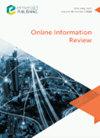用户如何选择在社交媒体上分享的内容:流量理论视角
IF 3.1
3区 管理学
Q2 COMPUTER SCIENCE, INFORMATION SYSTEMS
引用次数: 0
摘要
目的 本文研究了 FI 和 TD 对具有不同动机的社交媒体(SM)用户分享意愿的干预。所提出的模型将 TAM 应用于 "享乐动机系统"(Hedonic Motivation System),并包含了流动状态(flow state)的替代途径。从 "社交媒体分享动机模型"(MSMSM)中得到的启示是,使用社交媒体获取信息的用户会沉浸其中,但分享的意图却不会因此而被激发。原创性/价值社交媒体用户怀有不同的动机,选择在过载的平台上分享精选内容。然而,不同动机在社交媒体上推动分享的机制仍有待探索。文献强调流动是分享的驱动力,而关于流动状态与社交媒体上的分享意向之间关系的研究结果却没有定论;一些研究估计两者之间存在正向显著关系,而另一些研究则认为两者之间存在部分或选择性显著关系。本研究探讨了诱导流动的两个维度(即专注沉浸(FI)和时间分离(TD))对 SM 上分享意愿的干预。本文章由计算机程序翻译,如有差异,请以英文原文为准。
How do users select the content they share on social media: flow theory perspective
PurposePaper studies the intervention of FI and TD on the sharing intention on social media (SM) users with different motivations.Design/methodology/approachThe mechanism for different motivations of SM users to influence sharing intention is explored using WarpPLS. The proposed model applies TAM in Hedonic Motivation System context and includes an alternate pathway of flow state.FindingsReciprocal relationship between FI and TD is empirically proven. Insights from the “Motivated Sharing Model for Social Media”(MSMSM) follow that users who use SM for information get immersed, however intention to share is not triggered by it.Practical implicationsThis study emphasizes on the compatibility of content characteristics with the gratifications of the motivations for SM use to achieve virality. Practitioners may use MSMSM to optimize content, so it appeals to the target audience and has a higher probability of being shared.Originality/valueSocial media users carry different motivations and choose to share select content on the overloaded platform. However, the mechanism for different motivations to drive sharing on SM has remained unexplored. Literature highlights flow as the driver of sharing, whilst the findings on the relationship between flow state and sharing intention on SM are inconclusive; some estimate a positively significant relationship, while others find it to be partially or selectively significant. In this study, intervention of the two dimensions of induced flow: namely, focused immersion (FI) and temporal dissociation (TD)—on the sharing intention on SM is examined.
求助全文
通过发布文献求助,成功后即可免费获取论文全文。
去求助
来源期刊

Online Information Review
工程技术-计算机:信息系统
CiteScore
6.90
自引率
16.10%
发文量
67
审稿时长
6 months
期刊介绍:
The journal provides a multi-disciplinary forum for scholars from a range of fields, including information studies/iSchools, data studies, internet studies, media and communication studies and information systems.
Publishes research on the social, political and ethical aspects of emergent digital information practices and platforms, and welcomes submissions that draw upon critical and socio-technical perspectives in order to address these developments.
Welcomes empirical, conceptual and methodological contributions on any topics relevant to the broad field of digital information and communication, however we are particularly interested in receiving submissions that address emerging issues around the below topics.
Coverage includes (but is not limited to):
•Online communities, social networking and social media, including online political communication; crowdsourcing; positive computing and wellbeing.
•The social drivers and implications of emerging data practices, including open data; big data; data journeys and flows; and research data management.
•Digital transformations including organisations’ use of information technologies (e.g. Internet of Things and digitisation of user experience) to improve economic and social welfare, health and wellbeing, and protect the environment.
•Developments in digital scholarship and the production and use of scholarly content.
•Online and digital research methods, including their ethical aspects.
 求助内容:
求助内容: 应助结果提醒方式:
应助结果提醒方式:


